This 15 inch blustery event made the previous morning’s 5 inch “wintery mix” look like a harmless dusting. Â This storm was the real winter storm, not a December fluff festival that can be swept off the sidewalk with a broom. This was a heavy wet snow, that blew sideways and stuck to every surface it made contact with. Â It was accompanied with lightning and thunder. Â This is the snow that threatens trees that are covered with vines.
Around 10:00 last night we heard cracking sounds coming from the park. Â They sounded like gunshots, popping off one after the other. Â I knew what they were from the direction of the sound. Â It was the Norway Maple grove (Acer platanoides) growing not far from the house, in a blighted area, so full of invasives it has actually been de-prioritized from invasive removal projects in favor of areas with large and diverse native populations at risk of emerging invasives.
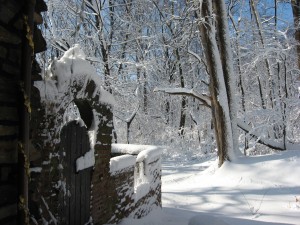
The forest was a pretty sight, the job of shoveling the front walk and the sidewalk was not. Always the worry of getting salt on the garden. Last year it was very possible that salt caused our cultivated wild Ginger (Asarum canadense) to have brown spots on the leaves.
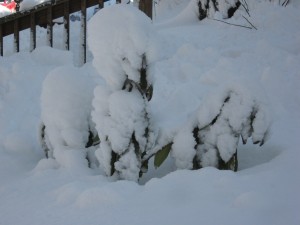
The Rosebay Rhododendron (Rhododendron maximum) is such a good sport under our tenure. It is doing much better since we planted it in the yard after we left it in its nursery pot in the back alley for the entire summer of 2007, hardly watering it.
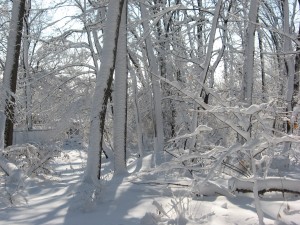
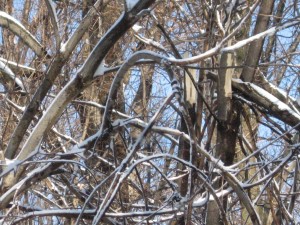
In the upper right section of the picture, the carnage is visible. Â These invasive trees introduced from Europe, are dominating this one area, shading out native plants and trees with their dense canopy. They were covered with grape vines (Vitis spp.) and the vines were so dense on the trees, that they caught enough snow to weigh them down to collapse at 10:00 last night. This is not a loss at all for the health of the forest, however we have found many, many native and ecologically important trees destroyed by this process.
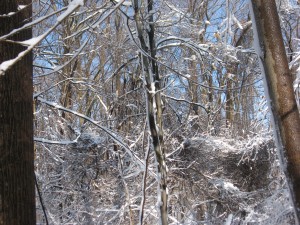
Some of the most vulnerable native trees destroyed by the combination of Grape vines and snow are Tulip Poplar (Liriodendron tulipifera) and Sassafrass (Sassafrass albidum). Â These are both fast-growing pioneer species, important in forest regeneration, something we take very seriously in an urban degraded forest situation. However, the cost to their rapid forest-building characteristics is their weak wood, easily broken in a compromised position. Â Grape is a forest edge vine that does contribute food for birds and has an ecological value. Â It is generally found on the rivers edge, or on other edges of forests.
However in a disturbed urban forest, the grape vine thrives, so much so that it maintains a forest edge state by overtaking any and all trees that try to grow. Â In this state, other invasives such as Oriental Bittersweet (Celastrus orbiculatus) and Japanese Honeysuckle (Lonicera japonica) among a whole host of others, also climb over the tree saplings, creating the inpenetrable thicket, the death knell of the potential forest. Â In the final stages of this commonly found environmental degradation, a monolithic aggregation of just a few species of plants remain. Contributing little or nothing to native birds and insects, what is left is a dead zone, completely incomparable in value and quality to the original forest that was once there. Â Here, the invasive trees are being toppled by the native Grape vines (We are not absolutely sure of the native status of the local population, actually). Â When an ecosystem is out of balance, all kinds of things can happen.
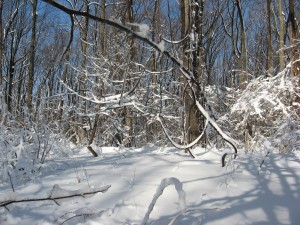
The snow brings so many striking contrasts and great shadows. The forest we are used to on a day-to-day basis has been transformed drastically and with such a beautiful effect. Â This winter we have had so many different types of snow events, each one with a unique stamp on the forest. Â This most recent snowstorm is most characteristic of a mature winter in our Mid-Atlantic, Piedmont location.
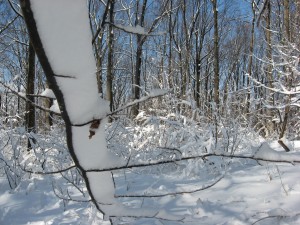
So interesting how the snow collected on this fairly young Tulip Poplar.
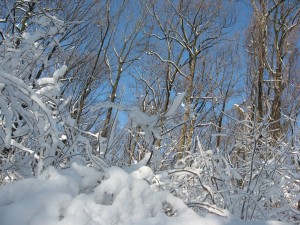
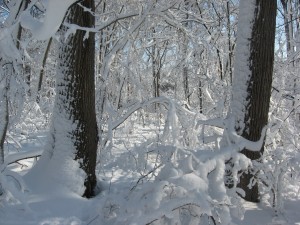
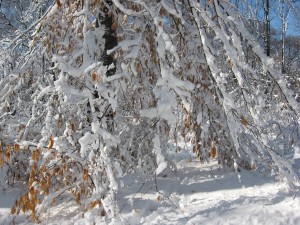
Here, the Beech tree is really weighed down by the snow attached to the leaves still on it’s lower branches. Why the leaves stay on through the winter is still a mystery. What evolutionary advantage does this have?
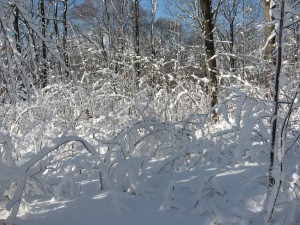
In this area, after this snowstorm, the rubber meets the road. Â This is an area where we have removed many vines off of these trees during the fall, with this very situation in mind. The little trees are holding their own and are not broken or splitting. This picture is a testament to our success. For the winter of 2010-2011, these young trees are saved. Â What a beautiful way to see our achievement.
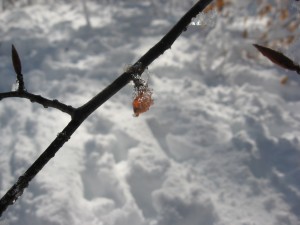
The Beech (Fagus grandifolia) buds , here covered in ice, have a red color, beautifully illuminated in the sun.
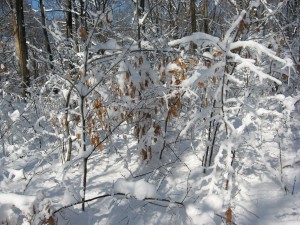
Just yesterday in the “wintery mix” discussion, this very tree was illustrated as a Fagacae family member holding onto its leaves in the winter like the Beeches and the Oaks. Â Now its bent down under the weight.
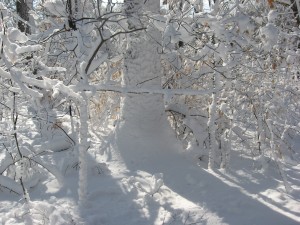
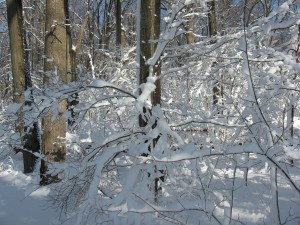
Just yesterday, again, this Dogwood tree (Cornus florida) was featured, with little clusters of snow mimicking its spring flowers. With a little imagination yesterday, that was possible, that a little winter snow could resemble a spring inflorescence.
Not so today. This is a whole different scene. Yesterday was the make-believe. Today is truly winter in all its glory. So, if its going to be like this, we wont mention spring anymore then. Not for now at least.
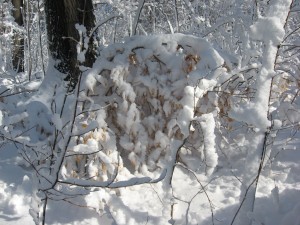
We  hope that this one will make it through these challenging times.
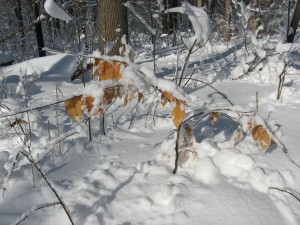
This little guy seems to be holding its own quite well. Â (Fagus grandifolia)



Your photos are beautiful, especially the ones taken with the CanonA550, although the Vivicam pix have a pleasing softness and faded look that works well on some scenes.
Thank-you for the feedback. The Vivicam fits in the pocket easily, great for a workday in rough terrain. The Canon A550 is for leisurely walks and photographically-inclined outings.